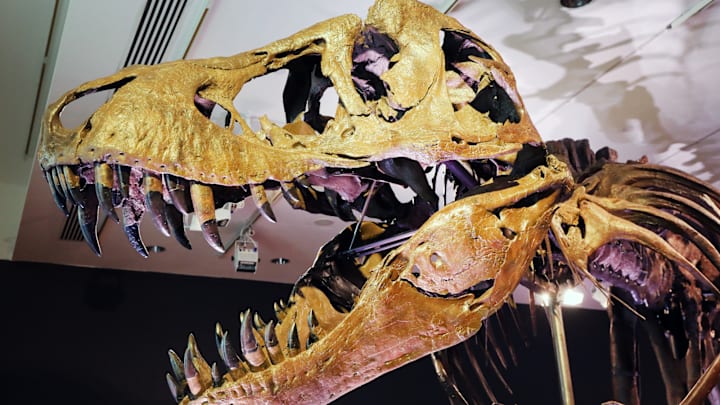In popular media, dinosaurs are often shown skulking through steamy rainforests or sweltering swamps. Depictions of the creatures in chillier settings are much rarer, but research indicates they do have some basis in history. A new study shows evidence of freezing temperatures at higher latitudes roughly 201 million years ago, countering the long-held assumption that all Late Triassic dinosaurs lived in warm environments. The findings could also explain how T. rex's feathered ancestors survived the extinction that wiped out nearly half of all quadrupeds.
For their study, published in the journal Science Advances, an international team of scientists analyzed sediment from lakes in northern China that formed during the Triassic period. They found ancient minerals they suspect were transferred into deep water by ice, indicating that the lakes had frozen over when they were still fairly young. The rock strata containing the minerals also bore dinosaur footprints. If temperatures in northern China dipped below freezing at this time, cold weather was likely felt across the Arctic region.
Many experts describe the Earth during this period as a "hothouse" planet, and for good reason. When Pangea began to break apart roughly 201 million years ago, volcanoes spewed an apocalyptic amount of lava and debris. The levels of carbon dioxide in the atmosphere doubled to up to 4000 parts per million (it's around 420 parts per million today). This triggered a greenhouse effect that sent the planet into a global warming. By the end of the Triassic period, 40 percent of all four-legged land animals had gone extinct.
The exact cause of the End Triassic Extinction, and why it impacted some species and not others, has been unclear. The new study shows that volcanic winters may have played a part.
"We know that the extinction was associated, and most likely triggered by, a continental scale volcanic eruption," Morgan Schaller, study co-author and associate professor of earth and environmental sciences at Rensselaer Polytechnic Institute, said in an email to Mental Floss. "[...] the previous thinking was that the kill mechanism at the extinction was due to sudden (thousand-year scale) global warming due to the increase in CO2 (a pretty effective greenhouse gas)."
"Though that certainly did happen, the more likely 'kill mechanism' for the extinction was a very short-lived (decadal?) and extreme cooling that immediately followed the eruptions."
Sulfate aerosol shot into the upper atmosphere by volcanos may have reflected solar radiation away from Earth, resulting in cold weather at higher latitudes—similar to how the volcanic eruption of Mount Tambora in 1815 led to Europe's "year without a summer." Temperatures may have dropped by as much as 18 degrees after the Late Triassic eruptions, according to the study.
Though these volcanic winters would have lasted only decades before the warming climate took over—a blink in geologic time—the effects were likely profound. Many large land animals without built-in insulation, like big-bodied prehistoric crocodiles, perished during this period. Smaller avian dinosaurs with insulation, meanwhile, were able to survive the End Triassic Extinction and dominate the next era.
"The avian dinosaurs were most likely feathered—meaning they had effective insulation and were cold-adapted, allowing them to survive through the cold temperatures produced by volcanic winters," Schaller says. "Until their non-insulated competitors (large, un-insulated reptiles) were wiped out in the extinction, the feathered dino forms could not move into tropical realms. Dinosaurs, and their close relatives, are actually cold-adapted animal forms."
Feathers allowed avian dinosaurs to thrive on a volatile planet and evolve into massive predators, like the Tyrannosaurus rex, which thrived up until the K–T extinction.
The new research paints the mass extinction event at the end of the Triassic in a new light. Though it was a period of death and destruction for much of the planet, it was also an opportunity for adaptation and survival for Earth's most resilient creatures.
